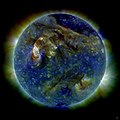File:Sun - August 1, 2010.jpg

Size of this preview: 673 × 599 pixels. Other resolutions: 270 × 240 pixels | 539 × 480 pixels | 862 × 768 pixels | 1,150 × 1,024 pixels | 2,300 × 2,048 pixels | 4,095 × 3,647 pixels.
Original file (4,095 × 3,647 pixels, file size: 1.39 MB, MIME type: image/jpeg)
File history
Click on a date/time to view the file as it appeared at that time.
| Date/Time | Thumbnail | Dimensions | User | Comment | |
|---|---|---|---|---|---|
| current | 19:25, 22 May 2012 |  | 4,095 × 3,647 (1.39 MB) | Rainald62 | Several rounds of editing, especially the last one, degraded the quality. I went back to the original (NASA) version, applied only clipping (removing the earth at the lower right corner) and very minor compression keeping much more detail. |
| 17:36, 14 March 2011 |  | 4,096 × 4,096 (944 KB) | A7N8X | correct contrast | |
| 13:34, 12 August 2010 |  | 4,096 × 4,096 (4.42 MB) | Hive001 | took Earth out | |
| 12:36, 9 August 2010 |  | 4,096 × 4,096 (4.23 MB) | Hive001 | ||
| 12:17, 9 August 2010 |  | 4,096 × 4,096 (3.88 MB) | Hive001 | {{Information |Description={{en|1=On August 1, 2010, almost the entire Earth-facing side of the sun erupted in a tumult of activity. This image from the Solar Dynamics Observatory of the news-making solar event on August 1 shows the C3-class solar flare ( |
File usage
The following 3 pages use this file:
Global file usage
The following other wikis use this file:
- Usage on ar.wikipedia.org
- Usage on ast.wikipedia.org
- Usage on bg.wikipedia.org
- Usage on ca.wikipedia.org
- Usage on ckb.wikipedia.org
- Usage on co.wikipedia.org
- Usage on de.wikipedia.org
- Usage on en.wikipedia.org
- Talk:Solar flare
- Extreme ultraviolet
- Wikipedia:Featured pictures/Space/Understanding
- User talk:Hive001
- User:Hive001/Maturation Chamber
- Wikipedia:Featured pictures thumbs/24
- Wikipedia:Featured picture candidates/August-2010
- Wikipedia:Featured picture candidates/Sun - August 1, 2010.jpg
- Wikipedia talk:Featured picture candidates/Archive 31
- Wikipedia:Wikipedia Signpost/2011-04-04/WikiProject report
- Wikipedia:Picture of the day/May 2012
- User:Xophist/s0
- Template:POTD/2012-05-21
- Wikipedia:Main Page history/2012 May 21
- Wikipedia:Wikipedia Signpost/Single/2011-04-04
- User:Huggums537
- Usage on es.wikipedia.org
- Usage on fa.wikipedia.org
- Usage on fa.wikibooks.org
- Usage on hr.wikipedia.org
- Usage on id.wikipedia.org
- Usage on ja.wikipedia.org
- Usage on kab.wikipedia.org
- Usage on ka.wikipedia.org
- Usage on km.wikipedia.org
- Usage on kn.wikipedia.org
- Usage on ko.wikipedia.org
View more global usage of this file.


